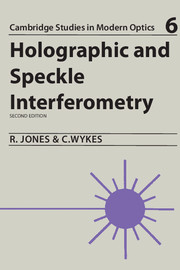Book contents
- Frontmatter
- Contents
- Preface to the first edition
- Preface to the second edition
- Acknowledgements
- 1 Basic optical principles
- 2 Holographic interferometry
- 3 Speckle pattern interferometry
- 4 Electronic Speckle Pattern Correlation Interferometry
- 5 Holographic and speckle pattern interferometry techniques for shape measurements
- 6 Experimental design and technique
- 7 Applications
- Appendices
- References
- Index
7 - Applications
Published online by Cambridge University Press: 05 August 2012
- Frontmatter
- Contents
- Preface to the first edition
- Preface to the second edition
- Acknowledgements
- 1 Basic optical principles
- 2 Holographic interferometry
- 3 Speckle pattern interferometry
- 4 Electronic Speckle Pattern Correlation Interferometry
- 5 Holographic and speckle pattern interferometry techniques for shape measurements
- 6 Experimental design and technique
- 7 Applications
- Appendices
- References
- Index
Summary
Introduction
The purpose of this chapter is to provide the reader with an insight into the way in which the holographic and speckle techniques described in the previous chapters may be applied to the solution of practical problems. Over the past five years there has been a significant increase in both the scope and volume of applications (see, e.g. references 1 and 2). This has been due to a number of factors; these include: a greater familiarity with laser techniques, the availability of commercial equipment and, perhaps most important, the increasing requirement to improve the performance of engineering components, systems and materials in a wide range of critical areas. It is not, therefore, possible in a single chapter to provide an exhaustive description of all of the current application work. Instead, the contents have been arranged in sections considered to be representative of the most important areas of application. These are as follows:
(a) the study of the static and dynamic deformation of complex structures;
(b) non-destructive testing and material property investigations;
(c) component inspection (for example, profile measurement);
(d) the investigation of flow in transparent media.
A number of case studies within each of the above categories are described; each of these demonstrates how a specific technical problem has been solved. Sections 7.2 and 7.3 relate to (a), Section 7.4 relates to (b) while (c) and (d) are covered in Sections 7.5 and 7.6 respectively.
- Type
- Chapter
- Information
- Holographic and Speckle Interferometry , pp. 274 - 320Publisher: Cambridge University PressPrint publication year: 1989
- 1
- Cited by



